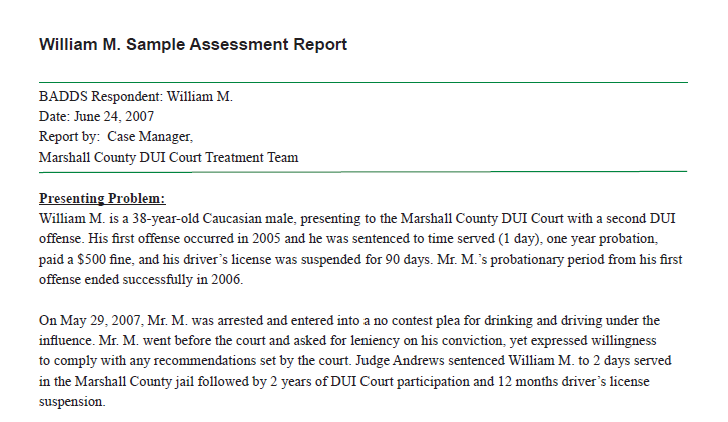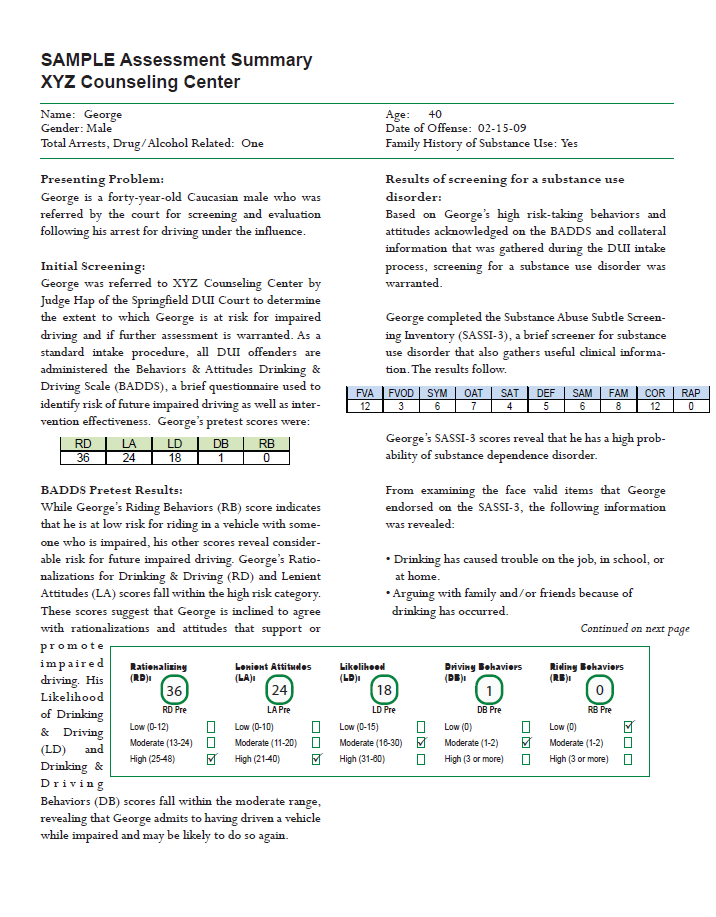
The Behaviors & Attitudes Drinking & Driving Scale (BADDS) is an evidence-based pre and posttest psychological questionnaire that measures attitudes, behaviors, and intervention effectiveness related to impaired driving.
The BADDS can identify:
- risk of future impaired driving and riding behaviors
- intervention effectiveness
- behavioral and attitudinal change after intervention
- rationalizations for drinking and driving
- history of impaired driving
Providers of prevention, intervention, and treatment of impaired drivers will find the BADDS to be an effective tool when measuring change.
Benefits:
- Predict risk of future impaired driving
- Easy and quick assessment aid for decision-making
- Measures change following intervention
- Evaluates program effectiveness
- Use in group or individual settings
- Only takes 15 minutes to administer and score
The BADDS is an empirically developed and validated psychological tool that measures attitudes, behaviors, and intervention effectiveness related to impaired driving. For more information about the Research behind the BADDS, visit our BADDS Research Page.
Available Downloads
Class/Group Change Assessment
Track and monitor group progress using the Class/Group Change Assessment form. Use results to modify program content and collect tangible evidence on intervention effectiveness.
BADDS Sample Assessment
Designed as a screening and assessment tool, the BADDS has multiple applications for its use. View a sample report to gain insight into how judges, probation officers, DUI/DWI educators and counselors use the BADDS.
How the BADDS can be used with the SASSI
Since releasing the BADDS, we have received numerous calls from clinicians interested in benefits of using the BADDS questionnaire with the SASSI to enhance the assessment process. View a sample summary report derived from the use of both questionnaires.
Frequently Asked Questions
A. The BADDS is comprised of 3 attitudes scales, 2 behavior scales, and other qualitative items. There is currently no way of adding these scale scores together to get a broader total score. Rather, clinicians should consider all of the scores as a whole in estimating someone’s drinking and driving risk.
A. It is recommended that the entire BADDS be completed. However, in the case where clinicians purposefully have clients skip items, make sure that ALL the items within a scale are completed before scoring.
A. The BADDS is probably not appropriate for use with children who are not nearing the driving age. For teens who are of driving age but under 18, the BADDS can be used in a pre/post fashion to evaluate prevention programs, but should not be used with anyone under 18 when the results of the BADDS could have legal consequences (like sentencing recommendations).
A. Yes, people can respond in a socially desirable way, and this should always be considered as a possibility. The BADDS is comprised of items that have a rather high amount of face validity, although the items on the Lenient Attitudes subscale are somewhat more subtle. Research on the BADDS indicates that despite the questions’ face validity, the BADDS does a very good job of discriminating those with low, moderate, and high risk of future drinking and driving behavior. In our research people have typically been very willing to admit to very risky behavior.
A. While some persons may attempt to ‘fake good’ on the BADDS, our research shows that even in circumstances where DUI offenders would be influenced to ‘fake good’ their responses on the BADDS continue to be 2-3 times higher than non-offenders.
A. You can send an email to badds@sassi.com to ask questions regarding research.
A. The BADDS was designed specifically to screen for risk of drinking and driving rather than as a general screening instrument for alcohol misuse or disorders. In addition it can be used in a pre and post format to measure intervention effectiveness. Research shows that the BADDS is highly sensitive to change. Therefore, the BADDS is useful both when it is used as a stand alone questionnaire for an initial evaluation and when measuring change.
A. There are multiple settings in which the BADDS can be used including:
- DUI Court programs including prevention, intervention, and treatment of impaired drivers
- DUI Probation departments
- Individual counseling
- Pre-release treatment planning in jails and prisons
- Universities and schools
- Research
A. The BADDS can be used whenever you wish to assess risk of impaired driving and riding behaviors. The BADDS is also a reliable and valid tool to assess intervention effectiveness. When the BADDS is administered as a pretest, participants’ responses can help highlight areas to target in a course of instruction. When the instrument is also administered as a posttest at the end of a course of intervention, BADDS change scores can help identify areas of continued impaired driving risk and areas of successful change.



